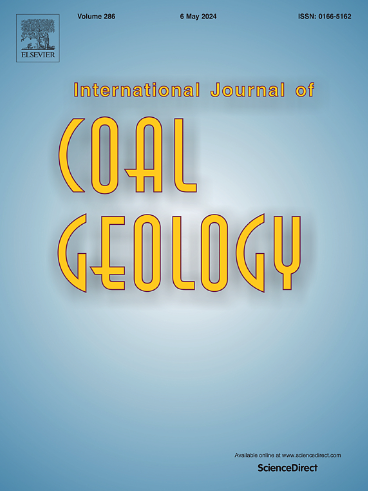Confocal laser-scanning microscopy (CLSM)-based thermal maturity of Tasmanites and progress in standardization of fluorescence microspectrometry
IF 5.7
2区 工程技术
Q2 ENERGY & FUELS
引用次数: 0
Abstract
Evaluation of thermal maturity in vitrinite-free or vitrinite-deficient sediments via fluorescence microspectrometry can provide relevant information related to petroleum exploration and thermal history assessment. However, variation in spectral fluorescence properties of alginite macerals with increasing thermal maturity is largely underexplored. Here, authors of this study have applied confocal laser-scanning microscopy (CLSM) in conjunction with fluorescence microspectrometry to a maturity series of marine Upper Devonian Tasmanites algae from the Ohio Shale (Huron Member) and a single sample from the Marcellus Formation of the Appalachian Basin. Spectral fluorescence properties of Tasmanites were evaluated in relation to orientation, measurement location, and the number of measurements per sample, and were compared to published literature. Emission spectra of Tasmanites from continuous wave laser excitation (405 nm) were acquired from sections perpendicular and parallel to bedding and at different positions within individual Tasmanites bodies. The results showed a progressive red-shift in emission maxima (λmax) in a large sample sized maturity series (N = 19), e.g., 493 to 578 nm for the perpendicular section at middle position. Further, blue-shifted apex and mineral-adjacent positions within sections perpendicular to bedding were observed, with the latter being reported here for the first time. While blue-shift at apex positions can be attributed to mechanical deformation-induced reorientation of photoselected fluorophores, the blue-shifted mineral-adjacent positions could result from strain loading and development of a plastic deformation region at the mineral contact zone with Tasmanites. A decrease in standard deviation with increasing number of measured emission maxima is well-observed, and 15 to 20 individual measurements per sample appears sufficient for low standard deviation and coefficient of variance. CLSM-derived thermal maturity parameters indicated that a moderate positive correlation of red/green quotient (Q650/500; R2 = 0.67) with solid bitumen reflectance (BRo in %) exists. For reproducible results, the determination of λmax and Q650/500 should be conducted exclusively in the middle position at perpendicular and parallel sections of the polished whole-rock pellets, where the lowest standard deviation in measurement was observed. These results strengthen the suitability and relevance of the CLSM technique in thermal maturity studies of dispersed organic matter (DOM) and contribute to the standardization of fluorescence microspectrometry methods in organic petrology investigation.
基于共聚焦激光扫描显微镜(CLSM)的塔斯马尼亚石热成熟度及荧光显微光谱标准化研究进展
利用荧光显微光谱法评价无镜质组或缺乏镜质组沉积物的热成熟度,可为油气勘探和热史评价提供相关信息。然而,随着热成熟度的增加,藻褐石矿物的光谱荧光特性的变化在很大程度上还没有得到充分的研究。在这里,本研究的作者将共聚焦激光扫描显微镜(CLSM)与荧光显微光谱相结合,对来自俄亥俄页岩(休伦段)的一系列海相上泥盆统塔斯马尼亚藻类和来自阿巴拉契亚盆地马塞勒斯组的单个样本进行了研究。塔斯马尼亚的光谱荧光特性与取向、测量位置和每个样品的测量次数有关,并与已发表的文献进行了比较。在连续波激光激发(405 nm)下,从垂直于层理平行的剖面和塔斯马尼亚个体不同位置获得了塔斯马尼亚的发射光谱。结果表明,在大样本量的成熟度序列(N = 19)中,发射最大值(λmax)呈递进红移,如垂直截面在中间位置为493 ~ 578 nm。此外,在垂直于层理的剖面内观察到蓝移顶点和邻近矿物的位置,后者在这里是首次报道。虽然顶点位置的蓝移可归因于光选择荧光团的机械变形引起的重新定向,但蓝移的矿物邻近位置可能是由于应变加载和与塔斯马尼亚矿物接触区塑性变形区域的发展造成的。可以很好地观察到,随着测量到的最大发射次数的增加,标准偏差减小,每个样本15至20个单独的测量似乎足以实现低标准偏差和方差系数。clsm导出的热成熟度参数表明,红绿商(Q650/500; R2 = 0.67)与固体沥青反射率(BRo in %)存在中度正相关。为了获得可重复性的结果,λmax和Q650/500的测定应该只在抛光的全岩球团的垂直和平行截面的中间位置进行,在那里观察到测量的标准偏差最小。这些结果加强了CLSM技术在分散有机质(DOM)热成熟度研究中的适用性和相关性,并有助于荧光显微光谱技术在有机岩石学研究中的标准化。
本文章由计算机程序翻译,如有差异,请以英文原文为准。
求助全文
约1分钟内获得全文
求助全文
来源期刊

International Journal of Coal Geology
工程技术-地球科学综合
CiteScore
11.00
自引率
14.30%
发文量
145
审稿时长
38 days
期刊介绍:
The International Journal of Coal Geology deals with fundamental and applied aspects of the geology and petrology of coal, oil/gas source rocks and shale gas resources. The journal aims to advance the exploration, exploitation and utilization of these resources, and to stimulate environmental awareness as well as advancement of engineering for effective resource management.
 求助内容:
求助内容: 应助结果提醒方式:
应助结果提醒方式:


